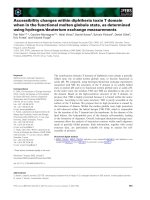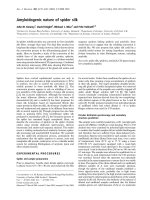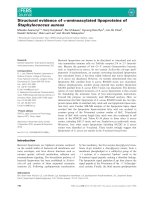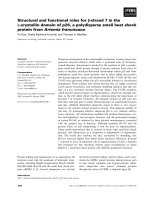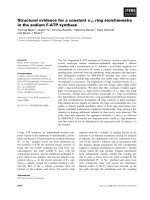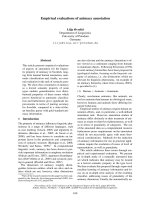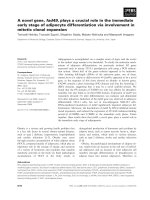Báo cáo khoa học: First evidence of catalytic mediation by phenolic compounds in the laccase-induced oxidation of lignin models ppt
Bạn đang xem bản rút gọn của tài liệu. Xem và tải ngay bản đầy đủ của tài liệu tại đây (314.65 KB, 7 trang )
First evidence of catalytic mediation by phenolic compounds
in the laccase-induced oxidation of lignin models
Francesca d’Acunzo and Carlo Galli
Dipartimento di Chimica, Universita
`
‘La Sapienza’, Roma, Italy; IMC-CNR Sezione Meccanismi di Reazione
The sulfonephthalein indicator, phenol red, exhibits an
unusually slow rate of oxidation by laccase from Polipo-
rus pinsitus, in spite of the fact that it is a phenol and
therefore a natural substrate for this phenoloxidase enzyme.
Nevertheless, after prolonged exposure to laccase (24 h)
phenol red is oxidized by more than 90%. We found that
phenol red, which can be oxidatively converted into a reso-
nance-stabilized phenoxy radical, performs as a mediator in
the laccase-catalyzed oxidation of a nonphenolic substrate
(4-methoxybenzyl alcohol) and also of a hindered phenol
(2,4,6-tri-tert-butylphenol). In particular, phenol red was
found to be at least 10 times more efficient than 3-hydr-
oxyanthranilate (a reported natural phenolic mediator of
laccase) in the oxidation of 4-methoxybenzyl alcohol. Other
phenols, which do not bear structural analogies to phenol
red, underwent rapid degradation and did not perform as
laccase mediators. On the other hand, several variously
substituted sulfonephthaleins, of different pK
2
values,
mediated the laccase catalysis, the most efficient being
dichlorophenol red, which has the lowest pK
2
of the series.
The mediating efficiency of phenol red and dichlorophenol
red was found to be pH dependent, as was their oxidation E
p
value (determined by cyclic voltammetry). We argue that the
relative abundance of the phenoxy anion, which is easier to
oxidize than the protonated phenol, may be one of the
factors determining the efficiency of a phenolic mediator,
together with its ability to form relatively stable oxidized
intermediates that react with the desired substrate before
being depleted in undesired routes.
Keywords: laccase; phenolic mediators; lignin models; radi-
cals; acidity.
Laccases (EC 1.10.3.2) are multicopper oxidases, produced
by micro-organisms and plants, which participate in nature
in both the biosynthesis and degradation of lignin [1]. In
the latter case, laccase operates in conjunction with other
ligninolitic enzymes, such as lignin peroxidase and man-
ganese peroxidase. The latter two enzymes, which are
stronger oxidants than laccase, are able to oxidize most
aromatic constituents of lignin, whereas laccase oxidizes
directly only the phenolic subunits, which are easier to
oxidize but relatively less abundant (15%). It has been
speculated [1], however, that laccase may react indirectly
with nonphenolic lignin components through mediation by
phenolic species present in its natural environment. These
Ônatural mediatorsÕ could be metabolites [2], or even lignin
fragments [3] generated by the other ligninolitic enzymes,
and would open up alternative, possibly radical, routes to
the oxidation of nonphenolic components [1]. It is quite
reasonable to argue that natural mediators may participate
in the laccase-catalyzed oxidation of nonphenolic lignin
subunits in those micro-organisms that only rely on laccase
for their ligninolitic action [4,5], and a number of sub-
stances, such as phenolic acids [6,7] and 3-hydroxyanthrani-
late (HAA) [8], have indeed been proposed as natural
laccase mediators. However, in order to prime laccase
towards the oxidation of nonphenolic substrates, a large
excess of these mediators is often needed [7,9] or, at least, a
stoichiometric amount is required in the most favourable
cases [10]. This might be because phenolic mediators are,
themselves, ÔgoodÕ substrates for the enzyme. Laccase would
oxidize them to short-lived reactive species that undergo
further reactions (noncatalytic undesired routes in Fig. 1:
radical coupling, fragmentation, etc.), preventing their
reduction to the original state by the nonphenolic substrate
they are supposed to oxidize (Fig. 1, catalytic cycle).
As an example, dimerization of the phenolic compound,
HAA, once oxidized by laccase, is so fast and quantitative
that we exploited the formation rate of this dimer in a new
spectrophotometric assay of laccase activity in mixed
solvents [11].
In the context of our studies [12–15] on laccase-mediator
systems, and of the speculations on the natural role of
phenolic mediators [1], we were intrigued by the results of Li
et al. [9] on the violuric acid-mediated oxidation of phenol
red by laccase. It was reported, in fact, that some fungal
laccases oxidize phenol red (Fig. 2; an advocated phenolic
lignin model) at a negligible rate, but that this rate increases
substantially in the presence of violuric acid when it is added
in up to a 100· molar excess with respect to phenol red.
Why is phenol red oxidized so slowly, by laccase, that a
mediator (a large excess of violuric acid, in this case) is
needed in order to speed up its metabolization? By studying
Correspondence to C. Galli, Dipartimento di Chimica, Universita
`
ÔLa SapienzaÕ, 00185 Roma, Italy.
Fax: + 39 06 490 421, Tel.: + 39 06 4991 3386,
E-mail:
Abbreviations: ABTS, 2,2¢-azinobis(3-ethylbenzo-6-thiazolinesulfonic
acid); HAA, 3-hydroxyanthranilic acid; HBT, 1-hydroxybenzo-
triazole.
Enzyme: laccases (EC 1.10.3.2).
(Received 19 May 2003, revised 10 July 2003, accepted 14 July 2003)
Eur. J. Biochem. 270, 3634–3640 (2003) Ó FEBS 2003 doi:10.1046/j.1432-1033.2003.03752.x
the peculiar behaviour of phenol red and other phenol-
sulfonephthaleins we aimed to gain a better insight into the
interaction between laccase and phenols in general. More
specifically, we wished to identify the characteristics that a
phenol should have in order to be a good laccase mediator,
i.e. one that follows the catalytic cycle shown in Fig. 1
without being rapidly metabolized by the enzyme (undesired
routes). In this study, we first investigated the kinetics of
oxidation of phenol red by Poliporus pinsitus laccase in the
absence of any mediator, and then evaluated the ability of
phenol red to act as a laccase mediator in the oxidation of
a hindered phenol and of a nonphenolic compound. We
extended this study to other sulfonephthalein indicators,
characterized by different pK
2
values, and investigated the
effect of solution pH on the mediating ability of phenol red
and dichlorophenol red.
Materials and methods
Laccase
Laccase from P. pinsitus was kindly donated by Novo
Nordisk Biotech; it was purified by ion-exchange chroma-
tography on Q-Sepharose by elution with phosphate buffer;
laccase fractions with an absorption (A)
280
/A
610
ratio of
20–30 were considered sufficiently pure [16]. The collected
fractions were concentrated by dialysis in cellulose mem-
brane tubing (Sigma) against poly(ethylene glycol) to a final
activity of 9000 UÆmL
)1
, as determined spectrophotometri-
cally by the standard reaction with 2,2¢-azinobis(3-ethyl-
benzo-6-thiazolinesulfonic acid) (ABTS) [17].
Reagents
4-Methoxybenzylalcohol, HAA, 1-hydroxybenzotriazole
(HBT) and all phenols employed (Aldrich) were used as
received from the manufacturer. Buffers were prepared
using ultrapure water obtained from a MilliQ apparatus.
Kinetics of laccase-catalyzed oxidation of phenol red
and 2,4,6-trichlorophenol
In a 10-mm quarz UV-Vis cell, the reagent (phenol red or
2,4,6-trichlorophenol; 40 l
M
in 0.1-
M
citrate buffer, pH 5.0)
was allowed to react with 0.3 UÆmL
)1
of laccase at 25 °C.
Phenol red consumption was monitored at 420 nm, while
dichloroquinone formation was monitored at 273 nm, using
an HP 8453 diode array UV-Vis spectrophotometer run with
HP
UV
-
VIS CHEMSTATION
software. The rate of phenol red
oxidation is expressed as the initial rate of depletion of the
absorption at the wavelength followed (e.g. DA
420
Æ min
)1
), in
keeping with the literature [9]. The complexity of the kinetic
trend, i.e. a biphasic profile (Fig. 3), and the possibility that
the absorption at 420 nm may be also attributed to products
other than phenol red, prevented us from converting data
from absorbance units to concentration units.
Laccase-catalyzed oxidation of phenol red
Phenol red (20 l
M
in 0.1-
M
sodium citrate buffer, pH 5.0),
was incubated with 4 UÆmL
)1
of purified laccase for 24 h at
25 °C. The amount of residual phenol red, after metaboli-
zation by the enzyme, was determined by HPLC. The
internal standard (3,4-dimethoxybenzaldehyde) was added
to the reaction mix, which was then diluted in the mobile
Fig. 2. Structure of phenol red and related molecules.
Fig. 3. Degree of conversion of phenol red (thick line) and 2,4,6-tri-
chlorophenol (thin line) as a function of time. The kinetics of laccase-
catalyzed oxidation of phenol red and 2,4,6-dichlorophenol were
monitored spectrophotometrically through the decrease in absorption
at 420 nm and the increase in absorption at 273 nm, respectively.
Reaction conditions: phenol red or 2,4,6-trichlorophenol, 40 l
M
in
0.1
M
citrate buffer, pH 5.0; laccase, 0.3 UÆmL
)1
. Calculation of the
degree of conversion:
C ¼ 100
AðtÞÀAðt
0
Þ
Aðt
f
ÞÀAðt
0
Þ
where t
f
¼ 20 h for phenol red (>90% conversion by HPLC), but
t
f
¼ 4 h for trichlorophenol [the time at which A(t) has already
reached its plateau value]. The inset shows the spectrum of phenol red
at t ¼ 0andt ¼ 20 h; residual absorption at 420 nm after 20 h cannot
be entirely attributed to phenol red (according to HPLC data), but
rather to some unidentified product(s).
Fig. 1. The catalytic cycle of a laccase-mediator system, where the
oxidized mediator partitions between a significant undesired side-reaction
and a catalytic cycle of oxidation of a nonphenolic substrate.
Ó FEBS 2003 A phenolic mediator for the enzyme laccase (Eur. J. Biochem. 270) 3635
phase and filtered through 0.2-lm Teflon syringe filters
(Superchrom Varisep) prior to analysis. We used an Agilent
Technologies HPLC system (pump, degasser, UV-Vis
detector and solvent delivery system) equipped with a
Zorbax Agilent Eclipse XDB-C
8
15 cm · 4.6 mm column,
and run with Agilent
CHEMSTATION FOR LC
software. The
elution was carried out with an MeOH/H
2
O (40 : 60) mobile
phase containing 0.3& trifluoroacetic acid, at a flow rate of
0.8 mLÆmin
)1
, and products were detected at 265 nm.
Oxidation of lignin model compounds
4-Methoxybenzyl alcohol or 2,4,6-tri-t-butylphenol (Ald-
rich) (20 l
M
in 0.1
M
citrate buffer, pH 5.0), was incubated
for 24 h at 25 °Cwith4UÆmL
)1
of purified laccase and a
mediator (HAA, HBT, or one of the phenolic derivatives
listed in Table 1; 6.7 l
M
). Reaction products were identified
by GC-MS analysis, run on a HP 5892 GC equipped with a
12-m · 0.2 mm methyl silicone gum capillary column,
coupled to an HP 5962 MSD instrument operating at
70 eV. The yields of oxidation (yield of 4-methoxybenzal-
dehyde or consumption of 2,4,6-tri-t-butylphenol) were
determined by GC analysis with respect to p-methoxy-
acetophenone as the internal standard, using a Varian 3400
Star instrument fitted with a 20 m · 0.2 mm methyl silicone
gum capillary column coupled to an FID detector.
Cyclic voltammetry
The electrochemical equipment consisted of a computer-
controlled home-made potentiostat with a Vernier Soft-
ware
MULTI PURPOSE LABORATORY INTERFACE
(
MPLI
)pro-
gram for
WINDOWS
. The three-electrode system consisted of
a glassy-carbon disc (of 1.5 or 3 mm diameter) working
electrode, an aqueous Hg/HgCl
2
/saturated KCl reference
electrode (E° vs. NHE ¼ E° vs. SCE + 0.242 V), and a Pt
reference electrode (1 cm
2
). Prior to recording each scan, the
working electrode was polished using a Cypress Systems
polishing kit, sonicated for 1 min, and rinsed with distilled
water. All scans were obtained at room temperature.
NaH
2
PO
4
/Na
2
HPO
4
buffers (0.5
M
)atpH4.0and
pH 7.4, respectively, were prepared by carefully weighing
appropriate amounts of monobasic and dibasic phosphates,
which were dissolved in water previously filtered through a
MilliQÒ apparatus (Millipore, France). The cyclic voltam-
metry scans of 0.5-m
M
phenol red or dichlorophenol red in
solutions of different pH were run at a rate of 0.5 VÆs
)1
.The
cyclic voltammetry scans of 0.5 m
M
phenol red in the
presence of 2.5–30 m
M
4-methoxybenzyl alcohol were run
at a rate of 5 mVÆs
)1
.
Results and discussion
Kinetics of the laccase-catalyzed oxidation of phenol red
In a previous study, on the oxidation of oligomeric phenols,
we unambiguously pinpointed poor substrate solubility and
steric hindrance as two factors that make the use of a
mediator necessary for the laccase-catalyzed oxidation of
otherwise recalcitrant phenolic substrates [18]. Phenol red,
however, does not seem to present any steric problem, and
its solubility is not limited in aqueous solutions. Therefore,
its reported [9] lack of reactivity with laccase is puzzling.
By following the reaction spectrophotometrically at
420 nm, we found that the initial oxidation rate of phenol
red (3 · 10
)3
DAÆmin
)1
for a 1-h reaction time) in the
absence of a mediator was significantly slower than that of
2,4,6-trichlorophenol (Fig. 3), a structurally simple phenol
that laccase easily oxidizes to dichlorobenzoquinones (most
probably a mixture of o-andp-benzoquinone isomers, the
latter being the most abundant: see Fig. 4 for product
identification by MS [19]). However, the decrease in
absorption at 420 nm proceeded slowly throughout the
20-h time span during which the reaction was monitored
(the rate at 10–20 h was 3 · 10
)5
DAÆmin
)1
).
For a direct comparison of the kinetic data of phenol red
and 2,4,6-trichlorophenol, the degree of conversion of the
two phenols, as a function of time, was plotted (see the
equation in the legend to Fig. 3). Figure 3 clearly shows
that, while 2,4,6-trichlorophenol was quantitatively meta-
bolized within 2 h, the conversion of phenol red was only
% 80% after 5 h. HPLC analysis (where phenol red is
chromatographically separated from other components of
the reaction mixture that may absorb at 420 nm) indicated
that <10% residual phenol red was present after 20 h of
exposure to laccase. In Fig. 3 therefore the A
420
(at 20 h)
was taken as an approximation of the residual absorption at
ÔzeroÕ phenol red concentration. This residual absorption
may be attributed to some product(s) of phenol red
metabolization, which, in turn, could react slowly with
laccase. As a result, the kinetic curve is biphasic and the
data cannot be expressed simply in terms of phenol red
concentration.
Table 1. Phenolic structures investigated as laccase mediators in the
oxidation of 4-methoxybenzyl alcohol at pH 5.0, unless stated otherwise.
Reaction conditions: substrate, 20 m
M
in 0.1
M
citrate buffer, pH 5.0;
mediator concentration, 6.7 m
M
; laccase concentration, 4 UÆmL
)1
;
reaction time, 24 h. pK
ArOH
values obtained from refs [25], [26], [29]
and [30].
Entry Mediators investigated
Yield (%) of
4-methoxy-
benzaldehyde pK
ArOH
1 Phenol red 20 7.42
2 Phenol red, 24 h 35
3 Phenol red, pH 3.5 <5
4 Phenol red, pH 5.5 20
5 Phenol red, pH 6.0 15
6 Dichlorophenol red 55 5.74
7 Dichlorophenol red, pH 3.5 10
8 Dichlorophenol red, pH 5.5 30
9 Dichlorophenol red, pH 6.0 10
10 Cresol red 20 7.87
11 m-Cresol red 15 8.04
12 Phenolphthalein <5 9.4
13 Aurintricarboxylic acid <5 >7.2
14 Chrome azurol S <5
15 Resveratrol <5
16 Alizarin red <5
17 Quercetin <5
18 2,6-Dimethoxy-4-allylphenol <5
19 2,6-Dichloroindophenol <5
3636 F. d’Acunzo and C. Galli (Eur. J. Biochem. 270) Ó FEBS 2003
Oxidation of lignin model compounds
by the laccase/phenol red system
In the previous paragraph we presented evidence to suggest
that the laccase/phenol red couple is a Ôlong-lastingÕ reacting
system, compared, for example, with the laccase/2,4,6-
trichlorophenol couple. Phenol red is probably oxidatively
converted into a phenoxy radical [3], like any other laccase-
oxidizable phenol. If its phenoxy radical, or secondary
products thereof, were sufficiently long-lived, phenol red
might behave as a laccase mediator in radical oxidation
routes towards recalcitrant substrates [20]. We tested this
hypothesis in the oxidation of the nonphenolic 4-meth-
oxybenzyl alcohol, and also of the hindered 2,4,6-tri-
t-butylphenol. The former was not oxidized by laccase in the
absence of a mediator, whereas the latter yielded only a trace
of di-t-butylbenzoquinone (predominantly the p-benzoqui-
none isomer. See Fig. 4 for product identification by MS).
Oxidation of 4-methoxybenzyl alcohol. In Table 2 we
report the amount of substrate converted with phenol red
acting as the mediator, compared to the laccase/HAA
(a phenolic mediator) and laccase/HBT systems, HBT being
a well-known mediator of laccase, having an >N-OH
structure [15]. The mediator is always in defect with respect
to the substrate, unlike many phenolic mediators reported in
the literature [7,9]. The only product detected in the medi-
ated oxidations of 4-methoxybenzyl alcohol is 4-methoxy-
benzaldehyde, and recovery of the unreacted alcohol
complements the amount of product quantitatively.
Table 2 shows that, while the conversion of 4-meth-
oxybenzyl alcohol is much higher with HBT, phenol red is
at least 10 times more efficient than HAA, a reported
naturally occurring phenolic laccase mediator [8]. The
laccase/phenol red system maintains its oxidizing activity
even during the second day of reaction, when phenol red is
no longer present. Therefore, part of the mediation
efficiency of phenol red, compared with other structurally
simple phenols, is the result of by-products that are still
reactive towards the substrate.
Oxidation of 2,4,6-tri-t-butylphenol. Phenol red per-
formed significantly better than HBT as a mediator of
laccase in the oxidation of 2,4,6-tri-t-butylphenol to di-
t-butylbenzoquinone (predominantly p-benzoquinone
isomer: see Fig. 4 for product identification). The laccase-
generated phenoxy radical of phenol red, in this case, would
remove the H-atom from the OH group of the hindered
phenol in an almost thermoneutral step; the resulting 2,4,6-
tri-t-butylphenoxyl radical drives the reaction towards the
loss of isobutene and results in the observed di-t-butyl-
benzoquinones. Two moles of substrate are oxidized per
mole of mediator, indicating that phenol red participates in
a catalytic cycle such as the one described in Fig. 1.
A mechanistic parallel between N-hydroxy and phenolic
mediators
The laccase mediator, HBT, is oxidatively converted by the
enzyme into an >N–O
•
reactive intermediate [21,22].
Electrochemical data [23] show that the >N–O
•
radical of
HBT is sufficiently long-lived to be able to abstract a
benzylic hydrogen atom from a benzylic alcohol, converting
it into the aldehyde through the intervention of dioxygen
(Fig. 5). This route, via a radical, circumvents the low
tendency of a benzyl alcohol to be involved in an electron-
transfer route with laccase, and makes its oxidation possible
[13,21]. This hydrogen abstraction route is thermodynami-
cally feasible because the energy of the O–H bond that
N–O
•
forms is comparable to that of the benzylic C–H bond
that is cleaved from the substrate [12,21].
It can be suggested that, if the laccase-generated phenoxy
radical from phenol red is resonance-stabilized [24], and
therefore as long-lived as the >N–O
•
radical from HBT
Fig. 4. Fragmentation patterns that are diagnostic for o- and p-benzo-
quinone isomerism [19]. R ¼ Cl, m/z=52 (amenable to 2,6-dichloro-
benzoquinone) is the base peak; m/z=110 is 52% of the base peak.
R ¼ t-Bu, the abundance of m/z ¼ 52, 53, 67 (amenable to 2,6-di-
t-butylbenzoquinone) altogether is five times that of m/z ¼ 164; the
base peak is (M-43) ¼ 177.
Table 2. Oxidation (%) of 4-methoxybenzyl alcohol and 2,4,6-tri-t-
butylphenol by laccase/phenol red, compared with two other laccase-
mediator systems. The reaction conditions were as follows: substrate,
20 m
M
in 0.1
M
citrate buffer, pH 5.0; mediator concentration,
6.7 m
M
; laccase concentration, 4 UÆmL
)1
; reaction time, 24 h. HAA,
3-hydroxyanthranilic acid; HBT, 1-hydroxybenzotriazole.
Substrate
Mediator
Phenol red HAA HBT
4-Methoxybenzyl alcohol 20
a
2
a
[15] 75
a
[15]
35
a,b
––
2,4,6-tri-t-butylphenol 55
c
–30
c
a
Yield of aldehyde.
b
Reaction time: 48 h.
c
Yields of di-t-butyl-
benzoquinone were determined by gas chromatography.
Ó FEBS 2003 A phenolic mediator for the enzyme laccase (Eur. J. Biochem. 270) 3637
[22], it has time to follow an analogous H-abstraction route
of oxidation of the nonphenolic substrate. In fact, phenol
red is more acidic (pK
2
¼ 7.42) [25] than simple phenols
(pK
a
¼ 9–10) [26]. This is a result of the delocalization of
the negative charge of the anion onto the adjacent quinoid
ring (see Fig. 2). Analogously, delocalization of the un-
paired electron of the corresponding phenoxy radical onto
the quinoid ring would enhance the survival time of the
phenoxy radical intermediate from phenol red, giving it a
greater chance to take part in catalytic cycles (Fig. 1) before
being consumed in undesired routes. Because O–H bond
energies of phenols (approximately 82–88 kcalÆmol
)1
)are
similar to those of the C–H benzylic bonds of the alcohol
[21], the radical route of the phenoxy radical is as
thermodynamically feasible as that of the > N–O
•
species
from a >N–OH mediator. This suggested route bears
strong analogies to the reported mechanism of oxidation of
primary alcohols to aldehydes by the enzyme galactose
oxidase [27], where the phenoxy radical of a tyrosine residue
abstracts an H-atom from the alcoholic substrate [28].
Our hypothesis, that part of the mediating ability of
phenol red (i.e. besides the reactivity of its secondary
oxidation products) may be attributed to its phenoxy
radical, finds support in the following results obtained by
cyclic voltammetry. Figure 6 shows the irreversible vol-
tammogram corresponding to the oxidation of phenol red
to its phenoxy radical. More precisely, at the pH of the
experiment (7.4), phenol red (pK
2
¼ 7.42) is % 50%
deprotonated, so that the pH-dependent E
p
results from
both the oxidation of the phenol to the corresponding
radical cation (which rapidly releases a proton to yield the
phenoxy radical) and to the oxidation of the phenolate ion
to the phenoxy radical directly [29]. The scans run at pH 7.4,
in the presence of an increasing excess of 4-methoxybenzyl
alcohol, showed some increase in current intensity (% 10%
increase with a fivefold excess of 4-methoxybenzyl alcohol;
50% increase with a 60-fold excess; we were unable to
achieve a larger excess of alcohol because of its limited
solubility in the buffer). This indicates that phenol red is, at
least in part, regenerated from its phenoxy radical through
the abstraction of a benzylic hydrogen from the substrate,
so that it can be oxidized once again at the electrode, this
resulting in an increase of charge transport and therefore of
current intensity.
Effect of the p
K
2
of the mediator and of solution pH
on the laccase-catalyzed oxidation of
4-methoxybenzylalcohol
So far we have shown that the laccase/phenol red couple is
a long-lasting reacting system that is able to perform as a
laccase-mediator system. In our search for other types of
phenolic mediators, we tested a number of other phenolic
structures, mostly antioxidants, by means of the benchmark
oxidation of 4-methoxybenzylalcohol. Most turned out to
be unable to perform as mediators (Table 1, entries 15–19),
because they undergo rapid degradation. We believe that
the potential for the oxidative formation of highly conju-
gated (and, hence, stabilized) oxyradicals in structures akin
to phenol red may be responsible for their peculiar behavior.
We have provided some partial support to this view through
the electrochemical experiment depicted in Fig. 6 and
described above, in the previous paragraph. These consid-
erations, combined with the fact that sulfonephthaleins,
phenolphthaleins and related structures (Fig. 2) cover a
wide range of pK values for the dissociation of their
phenolic moiety, and that the oxidation potential of phenols
is modulated by solution pH (at pH < pK) [29], led us
to expand on the subject of phenol red-like mediators.
All sulfonephthaleins exhibit some mediating effect, while
aurintricarboxylic acid and chrome azurol S, which are the
only structures carrying an electron-withdrawing group on
the phenolic ring (Fig. 2), are not even oxidized by laccase
(as determined by UV-Vis spectrometry). The most suc-
cessful mediator is dichlorophenol red, which is the most
acidic (with a pK
2
of 5.74) [25] among the sulfonephthalein
structures tested. In fact, in Table 1, a correlation is
observed between 4-methoxybenzyl alcohol conversion
and the pK
2
of the sulfonephthalein mediator. It can be
argued that at the reaction pH of 5.0, the lower the pK
2
of
the mediator, the easier it is for laccase to oxidize it, as the
fraction of sulfonephthalein that is present in its phenolate
form (which is expected to be a better one-electron
reductant with respect to laccase, and consequently to be
more easily converted into the phenoxy radical by electron
transfer) is greater. In short, deprotonation of the phenolic
moiety seems to be the factor that turns a phenol red-like
structure from a somewhat slowly reacting laccase substrate
Fig. 6. Cyclic voltammetry scans (m = 5mVÆs
)1
) for 0.5 m
M
phenol red
at pH 7.4 in 0.5
M
NaH
2
PO
4
/Na
2
HPO
4
buffer in the presence of 0 m
M
(m), 2.5 m
M
(d)or30m
M
(j) 4-methoxybenzyl alcohol.
Fig. 5. The radical mechanism of oxidation of a nonphenolic substrate
by a laccase->N–OH mediator system.
3638 F. d’Acunzo and C. Galli (Eur. J. Biochem. 270) Ó FEBS 2003
into an efficient phenolic laccase mediator. Once again, we
resorted to electrochemical determinations in order to verify
whether there was any pH dependence of the E
p
of
sulfonephthaleins, and, if any, whether it proceeded in the
same direction as the pH dependence of the sulfonephtha-
lein mediators in Table 1. By increasing the pH (from 4.0 to
7.4) at which the cyclic voltammetry scans were run (see the
Materials and methods), we found a decrease of E
p
from
0.84 to 0.68 V vs. SCE for phenol red (compared with a
calculated increase in the phenolate/phenol ratio from
4 · 10
)4
to 1), and from 0.81 to 0.71 V for dichlorophenol
red (phenolate/phenol ratio from 2 · 10
)2
to 45). These
increments are in keeping with those reported by Li &
Hoffman [29] for phenol and 2-chlorophenol, and support
the idea that a slow-reacting phenolic mediator, which by
virtue of its lower pK is present in solution in a more easily
oxidizable form, should be a better laccase mediator.
Further support of this idea is provided by the pH
dependence of the laccase-mediating effect of phenol red
and dichlorophenol red (Table 1). Both sulfonephthaleins
are poor mediators at pH 3.5 compared with pH 5.0. On a
further increase of the pH solution (to a pH of ‡6) the
conversion of 4-methoxybenzyl alcohol again decreases,
because P. pinsitus laccase starts to lose its activity. Hence,
at % pH 5.0, a compromise is reached between activity of
the enzyme and partial (or substantial) deprotonation of the
mediator into a more oxidizable species.
Conclusions
Phenol red is a nonhindered, highly soluble phenol that
gives rise to a long-lasting laccase-phenolic mediator
system. It is an efficient mediator, compared with other
phenolic molecules [7], in that it does not need to be
present in large excess in order to obtain significant
conversion of laccase-resistant substrates. This favourable
feature of phenol red is shared by other sulfonephthalein
phenols, whereas other phenols tested, which do not have
this structural motif, were rapidly degraded by laccase and
failed to mediate. The peculiar behaviour of phenol red
(and related structures) may be the result of a combination
of several factors, such as (a) its phenoxy radical may be
longer lived than that of a simple phenol, because of
resonance stabilization, (b) this longer-living phenoxy
radical may give dimerization (a reaction generally respon-
sible for the instability of phenoxy radicals) less extensively
than other reactions, such as H-abstraction from a
substrate [this is supported by the observed regeneration
of phenol red, following its oxidation at the electrode, by
the presence of 4-methoxybenzyl alcohol (cf. Figure 6)] and
(c) this phenoxy radical, as suggested by spectrophoto-
metric determinations and HPLC data, may, in turn, form
secondary species (which we did not attempt to identify)
that can also act as mediators; it is possible that the latter
phenomenon occurs to an even greater extent with those
mediators that need to be used in large excess with respect
to their substrate [7,9]. In this study we also showed that
other structures based on the phenol red template can
mediate laccase catalysis towards recalcitrant substrates,
and that a correlation exists between their efficiency and
the acidity of their phenolic group. In particular, dichloro-
phenol red, the most acidic of the series we tested, was the
most efficient at mediating the oxidation of 4-methox-
benzyl alcohol. This correlation can be rationalized, based
on electrochemical evidence and pH dependence of
mediation efficiency, in terms of the larger fraction of the
more easily oxidizable phenolate vs. the slowly reacting
phenol form of these sulfonephthaleins. Clearly, phenol red
is only a modest model of the phenolic subunits of lignin.
Nevertheless, the new biogenic hypotheses that ascribe the
reported ligninolytic activity of some fungi to the laccase-
catalyzed formation of phenoxy radical species [1] from
suitable phenolic fragments, begin to receive support here.
Acknowledgements
Thanks are due to Novo Nordisk Biotech (Denmark) for their generous
gift of laccase. We also thank the EU project OXYDELIGN (grant
QLK5-CT-1999-01277) for financial support.
References
1. ten Have, R. & Teunissen, P.J.M. (2001) Oxidative mechanisms
involved in lignin degradation by white-rot fungi. Chem. Rev. 101,
3397–3413.
2. Bo
¨
hmer, S., Messner, K. & Srebotnik, E. (1998) Oxidation of
phenanthrene by a fungal laccase in the presence of 1-hydroxy-
benzotriazole and unsaturated lipids. Biochem. Biophys. Res.
Commun. 244, 233–238.
3. Thurston, C.F. (1994) The structure and function of fungal lac-
cases. Microbiology 140, 19–26.
4. Srebotnik, E., Jensen, K.A. Jr & Hammel, K.E. (1994) Fungal
degradation of recalcitrant non-phenolic lignin structures without
lignin peroxidase. Proc. Natl Acad. Sci. USA 91, 12794–12797.
5. Kapich, A.N., Hofrichter, M., Vares, T. & Hatakka, A. (1999)
Coupling of manganese peroxidase-mediated lipid peroxidation
with destruction of nonphenolic lignin model compounds and
14C-labeled lignins. Biochem. Biophys. Res. Commun. 259, 212–
219.
6. Itoh, K., Fujita, M., Kumano, K., Suyama, K. & Yamamoto, H.
(2000) Phenolic acids affect transformations of chlorophenols by
a Coriolus versicolor laccase. Soil Biol. Biochem. 32, 85–91.
7. Johannes, C. & Majcherczyk, A. (2000) Natural mediators in the
oxidation of polycyclic aromatic hydrocarbons by laccase medi-
ator systems. Appl. Environ. Microbiol. 66, 524–528.
8. Eggert,C.,Temp,U.,Dean,J.F.D.&Eriksson,K E.L.(1996)A
fungal metabolite mediates degradation of non-phenolic lignin
structures and synthetic lignin by laccase. FEBS Lett. 391,
144–148.
9. Li, K., Xu, F. & Eriksson, K E.L. (1999) Comparison of fungal
laccases and redox mediators in oxidation of a nonphenolic lignin
model compound. Appl. Environ. Microbiol. 65, 2654–2660.
10. Cantarella, G., Galli, C. & Gentili, P. (2003) Free radical vs.
electron-transfer routes of oxidation of hydrocarbons by laccase/
mediator systems. Catalytic or stoichiometric procedures. J. Mol.
Catal. B: Enzym. 22, 135–144.
11. Cantarella, G., d’Acunzo, F. & Galli, C. (2003) Determination of
laccase activity in mixed solvents. A comparison between two
chromogens in a spectrophotometric assay. Biotechnol. Bioeng. 82,
395–398.
12. d’Acunzo, F., Baiocco, P. & Galli, C. (2003) A study of the oxi-
dation of ethers with the enzyme laccase under mediation by two
N-OH-type compounds. New J. Chem. 27, 329–332.
13. Baiocco, P., Barreca, A.M., Fabbrini, M., Galli, C. & Gentili, P.
(2003) Promoting laccase activity towards non-phenolic sub-
strates: a mechanistic investigation with some enzyme/mediator
systems. Org. Biomol. Chem. 1, 191–197.
Ó FEBS 2003 A phenolic mediator for the enzyme laccase (Eur. J. Biochem. 270) 3639
14. Fabbrini, M., Galli, C., Gentili, P. & Macchitella, D. (2001) An
oxidation of alcohols by oxygen with the enzyme laccase and
mediation by TEMPO. Tetrahedron Lett. 42, 7551–7553.
15. Fabbrini, M., Galli, C. & Gentili, P. (2002) Comparing the cata-
lytic efficiency of some mediators of laccase. J. Mol. Cat. B:
Enzym. 16, 231–240.
16. Xu, F. (1996) Oxidation of phenols, anilines, and benzenethiols by
fungal laccases: correlation between activity and redox potentials
as well as halide inhibition. Biochemistry 35, 7608–7614.
17. Wolfenden, B.S. & Willson, R.L. (1982) Radical cations as
reference chromogens in kinetic studies of one-electron transfer
reactions: pulse radiolysis studies of ABTS. J. Chem. Soc. Perkin
Trans. 2, 805–812.
18. d’Acunzo, F., Galli, C. & Masci., B. (2002) Oxidation of phenols
by laccase and laccase-mediator systems. Solubility and steric
issues. Eur. J. Biochem. 269, 5330–5335.
19. Zhang, M Y., Carpenter, B.K. & McLafferty, F.W. (1991) Gas-
phase formation of four isomeric C
4
H
4
+
ions. Ionic isomer
quantitation with neutralization-reionization mass spectrometry.
J. Am. Chem. Soc. 113, 9499–9503.
20. Bumpus, J.A., Tien, M., Wright, D. & Aust., S.D. (1985) Oxida-
tion of persistent environmental pollutants by a white rot fungus.
Science 228, 1434–1436.
21. d’Acunzo, F., Baiocco, P., Fabbrini, M., Galli, C. & Gentili, P.
(2002) The radical rate-determining step in the oxidation of benzyl
alcohols by two N-OH-type mediators of laccase: the polar N-oxyl
radical intermediate. New J. Chem. 26, 1791–1794.
22. Castro, A.I.R.P., Evtuguin, D.V. & Xavier, A.M.B. (2003)
Degradation of biphenyl lignin model compounds by laccase of
Trametes versicolor in the presence of HBT and heteropolyanion
[SiW
11
VO
40
]
5–
. J. Mol. Catal. B: Enzym. 22, 13–20.
23. Bourbonnais, R., Leech, D. & Paice, M.G. (1998) Electrochemical
analysis of the interactions of laccase mediators with lignin model
compounds. Biochim. Biophys. Acta 1379, 381–390.
24. Kirste,B.,Grimm,M.&Kurreck,H.(1989)EPR,
1
H, and
13
C
ENDOR studies of a quintet-state
13
C-labeled galvinoxyl-type
tetraradical. J. Am. Chem. Soc. 111, 108–114.
25. Casula, R., Crisponi, G., Cristiani, F., Nurchi, V., Casu, M. & Lai,
A. (1993) Characterization of the ionization and spectral proper-
ties of sulfonephthalein indicators. Correlation with substituent
effects and structural features. Talanta 40, 1781–1788.
26. Perrin, D.D. (1965) Dissociation Constants of Organic Acids in
Aqueous Solution. Butterworths, London.
27. Silverman, R.B. (2000) Reduction and oxidation. In The Organic
Chemistry of Enzyme-Catalyzed Reactions, pp. 157–158. Academic
Press, San Diego, CA.
28. Wachter, R.M. & Branchaud, B.P. (1996) Molecular modeling
studies on oxidation of hexopyranoses by galactose oxidase.
An active site topology apparently designed to catalyze radical
reactions, either concerted or stepwise. J. Am. Chem. Soc. 118,
2782–2789.
29. Hoffman, M.Z. & Li, C. (1999) One-electron redox potentials
of phenols in aqueous solution. J. Phys. Chem. B 103, 6653–
6656.
30. Muramatsu, M. (1958) Studies on the interaction of surface films
with solute in solutions. Bull. Chem. Soc. Jpn 31, 864–871.
3640 F. d’Acunzo and C. Galli (Eur. J. Biochem. 270) Ó FEBS 2003
